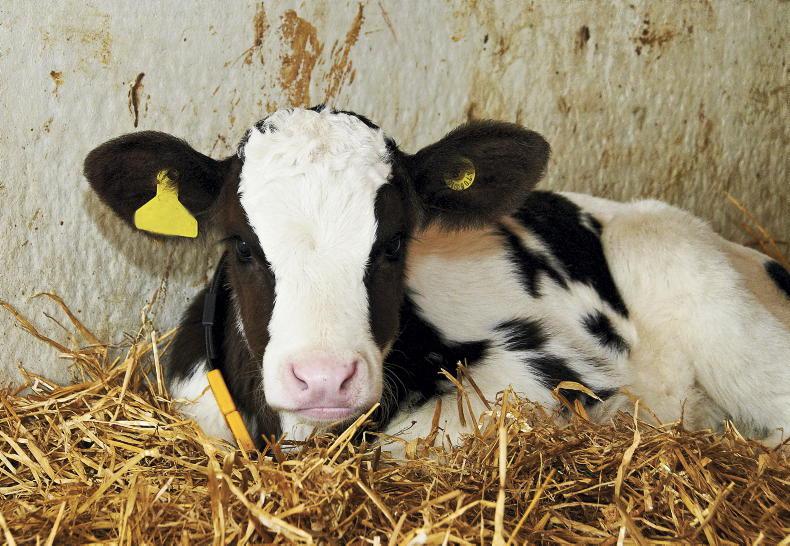Abomasal bloat is primarily caused by the excess fermentation of high-energy gastrointestinal contents in the abomasum (ie milk or milk replacer) along with the presence of fermentative enzymes produced by bacteria, many of which are always present in the stomach.
The calf must be provided with milk and many of the bacteria responsible for fermenting the milk are always present.
The two main factors involved in controlling the rate at which milk empties from the abomasum are milk volume per feed and osmolality - the concentration of the milk.
The volume of milk feed ingested alters the rate of abomasal emptying as a means of ensuring nutrients are presented to the small intestine at a constant rate while stabilising blood glucose levels.
The larger the volume of milk per feed, the longer it takes for the milk to empty from the abomasum. As research indicates, abomasal emptying rate for an entire meal is 40% slower when feeding four litres per feed compared with two litres per feed.

The onset of abomasal bloat is likely to involve a combination of management and nutritional factors.
On a computerised feeder, it is recommended to set the milk volume to a maximum of two to 2.5 litres per feed, while ensuring all meals are of an equal size. For twice-daily feeding, systems, limit milk to a maximum of three litres per feed.
Increasing solids concentration by adding more powder will delay abomasal emptying since the concentrated solution must be held in the lumen of the intestinal tract until sufficient water can be secreted to dilute the concentrated solution.
Fluids with an osmolality of more than 600 mOsm/l should be cautiously offered and should never be provided when water isn’t available.
Quality milk replacers
Most good-quality milk replacers can be mixed at either 12.5% (125g milk powder per litre of mixed milk) or 15% (150g milk powder per litre of mixed milk) with the aim of keeping the osmolality of the mixed milk at less than 500 to 600 mOsm/l.
To sustain osmolality and delay the rate of abomasal emptying, always provide fresh, clean ad-libitum water from day one. And if there are more than 20 calves per group, provide two water points.
Mixing milk replacer at 12.5% could also help to minimise the risk of ‘creating’ a high osmolality in calves where water consumption is low or in diarrheic, dehydrated calves.
Good calf health starts with excellent colostrum management, with stomach tubing often the method of choice.
Abomasal motility is predominantly controlled by the ventral branch of the abdominal vagal nerve - vagal reflex is responsible for accommodation and relaxation of the abomasum while the calf is eating.
Oesophageal/pharyngeal injury which leads to oesophageal lesions can damage the intricate vagal nerve branches responsible for eructation, swallowing and forestomach motility.
The incorrect use of an oesophageal tube or a tube that is cold, hard or damaged will increase the risk of pharyngeal injuries. A bottle and teat to feed colostrum is recommended. The tube must be soft, clean and in good condition and inserted by a trained individual: a calf should only be tubed once.
The bacterium suspected as the cause of abomasal bloat is a clostridial bacteria, although other organisms may be involved, including salmonella typhimurium; many of which are continuously present in the calf’s stomach.
The low production of acid in the abomasum and limited production of trypsin (responsible for the digestion of beta toxin, produced by clostridia) in the intestine, coupled with large amounts of milk/milk replacer increase the risk for rapid overgrowth by clostridia.
Clostridium perfringens type A is commonly found in many environments including the normal bovine intestinal tract along with water, contaminated or improperly thawed colostrum/milk and calf housing environments.
Anything that encourages the growth of such bacteria will increase the risk of poor calf health and the onset of bloat. A high level of cleaning and hygiene of the feeding equipment is essential in making any system a success.
Cleaning protocols
Strict adherence to the recommended cleaning protocols is essential to minimise the bacterial load on computerised feeders, with particular attention to the teats and tubes.
Teats should be swapped for a clean once daily (or even twice daily) – and should be removed, washed, rinsed and placed in a bucket of sterilising solution, ready for next day use.
Running automated cleaning functions on computerised feeders several times a day, together with manual cleaning, helps to reduce bacterial contamination in milk. The type of detergent used is also paramount, since most feeders are set to operate at temperatures of 45°C to 55°C.
Wet weather is also thought to have a significant impact on the microbiological water quality. Using water with a high bacterial load to mix milk replacer and/or as a source of drinking water will pose an increased risk for poor calf health. If a private water supply is used, consider testing for bacterial content.
Group size
Group size is a key factor in calf health. Bigger groups are associated with more stress, more disease and poor health. Calves in larger groups tend to drink their milk feed faster and in fewer visits than calves housed in smaller groups.
An ideal group size for young calves is 12 to 15 calves per group (maximum of 20 calves per group). Computerised feeders are designed to feed 30 to 35 calves per feed station.
If calves are housed in these larger groups, minimise the age range between the calves within the group (ideally seven days, maximum 21 days range) and ensure there are enough water points (as a guide, allow two water points per 20 calves).
The onset of abomasal bloat is a complex issue; its exact cause remains unknown. It is likely to involve a combination of both management and nutritional factors – when several of these risk factors come together at one time, they likely overload individual calves resulting in bloat.
During an outbreak of abomasal bloat, it’s important to consider all potential risk factors and make appropriate changes in response to its unwelcome arrival.
Abomasal bloat is primarily caused by the excess fermentation of high-energy gastrointestinal contents in the abomasum (ie milk or milk replacer) along with the presence of fermentative enzymes produced by bacteria, many of which are always present in the stomach.
The calf must be provided with milk and many of the bacteria responsible for fermenting the milk are always present.
The two main factors involved in controlling the rate at which milk empties from the abomasum are milk volume per feed and osmolality - the concentration of the milk.
The volume of milk feed ingested alters the rate of abomasal emptying as a means of ensuring nutrients are presented to the small intestine at a constant rate while stabilising blood glucose levels.
The larger the volume of milk per feed, the longer it takes for the milk to empty from the abomasum. As research indicates, abomasal emptying rate for an entire meal is 40% slower when feeding four litres per feed compared with two litres per feed.

The onset of abomasal bloat is likely to involve a combination of management and nutritional factors.
On a computerised feeder, it is recommended to set the milk volume to a maximum of two to 2.5 litres per feed, while ensuring all meals are of an equal size. For twice-daily feeding, systems, limit milk to a maximum of three litres per feed.
Increasing solids concentration by adding more powder will delay abomasal emptying since the concentrated solution must be held in the lumen of the intestinal tract until sufficient water can be secreted to dilute the concentrated solution.
Fluids with an osmolality of more than 600 mOsm/l should be cautiously offered and should never be provided when water isn’t available.
Quality milk replacers
Most good-quality milk replacers can be mixed at either 12.5% (125g milk powder per litre of mixed milk) or 15% (150g milk powder per litre of mixed milk) with the aim of keeping the osmolality of the mixed milk at less than 500 to 600 mOsm/l.
To sustain osmolality and delay the rate of abomasal emptying, always provide fresh, clean ad-libitum water from day one. And if there are more than 20 calves per group, provide two water points.
Mixing milk replacer at 12.5% could also help to minimise the risk of ‘creating’ a high osmolality in calves where water consumption is low or in diarrheic, dehydrated calves.
Good calf health starts with excellent colostrum management, with stomach tubing often the method of choice.
Abomasal motility is predominantly controlled by the ventral branch of the abdominal vagal nerve - vagal reflex is responsible for accommodation and relaxation of the abomasum while the calf is eating.
Oesophageal/pharyngeal injury which leads to oesophageal lesions can damage the intricate vagal nerve branches responsible for eructation, swallowing and forestomach motility.
The incorrect use of an oesophageal tube or a tube that is cold, hard or damaged will increase the risk of pharyngeal injuries. A bottle and teat to feed colostrum is recommended. The tube must be soft, clean and in good condition and inserted by a trained individual: a calf should only be tubed once.
The bacterium suspected as the cause of abomasal bloat is a clostridial bacteria, although other organisms may be involved, including salmonella typhimurium; many of which are continuously present in the calf’s stomach.
The low production of acid in the abomasum and limited production of trypsin (responsible for the digestion of beta toxin, produced by clostridia) in the intestine, coupled with large amounts of milk/milk replacer increase the risk for rapid overgrowth by clostridia.
Clostridium perfringens type A is commonly found in many environments including the normal bovine intestinal tract along with water, contaminated or improperly thawed colostrum/milk and calf housing environments.
Anything that encourages the growth of such bacteria will increase the risk of poor calf health and the onset of bloat. A high level of cleaning and hygiene of the feeding equipment is essential in making any system a success.
Cleaning protocols
Strict adherence to the recommended cleaning protocols is essential to minimise the bacterial load on computerised feeders, with particular attention to the teats and tubes.
Teats should be swapped for a clean once daily (or even twice daily) – and should be removed, washed, rinsed and placed in a bucket of sterilising solution, ready for next day use.
Running automated cleaning functions on computerised feeders several times a day, together with manual cleaning, helps to reduce bacterial contamination in milk. The type of detergent used is also paramount, since most feeders are set to operate at temperatures of 45°C to 55°C.
Wet weather is also thought to have a significant impact on the microbiological water quality. Using water with a high bacterial load to mix milk replacer and/or as a source of drinking water will pose an increased risk for poor calf health. If a private water supply is used, consider testing for bacterial content.
Group size
Group size is a key factor in calf health. Bigger groups are associated with more stress, more disease and poor health. Calves in larger groups tend to drink their milk feed faster and in fewer visits than calves housed in smaller groups.
An ideal group size for young calves is 12 to 15 calves per group (maximum of 20 calves per group). Computerised feeders are designed to feed 30 to 35 calves per feed station.
If calves are housed in these larger groups, minimise the age range between the calves within the group (ideally seven days, maximum 21 days range) and ensure there are enough water points (as a guide, allow two water points per 20 calves).
The onset of abomasal bloat is a complex issue; its exact cause remains unknown. It is likely to involve a combination of both management and nutritional factors – when several of these risk factors come together at one time, they likely overload individual calves resulting in bloat.
During an outbreak of abomasal bloat, it’s important to consider all potential risk factors and make appropriate changes in response to its unwelcome arrival.











SHARING OPTIONS